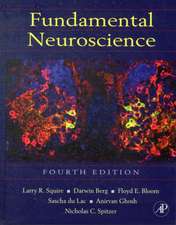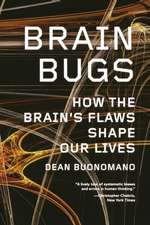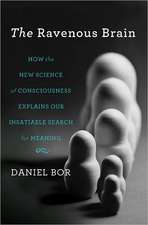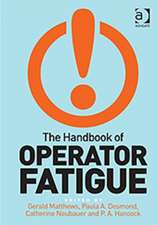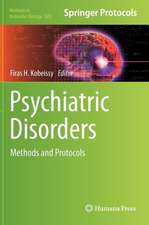Brain and Behavior in Child Psychiatry
Editat de Aribert Rothenbergeren Limba Engleză Paperback – 22 aug 2014
Preț: 376.57 lei
Preț vechi: 396.40 lei
-5% Nou
Puncte Express: 565
Preț estimativ în valută:
72.06€ • 75.42$ • 59.97£
72.06€ • 75.42$ • 59.97£
Carte tipărită la comandă
Livrare economică 31 martie-14 aprilie
Preluare comenzi: 021 569.72.76
Specificații
ISBN-13: 9783642753442
ISBN-10: 3642753442
Pagini: 440
Ilustrații: XXI, 414 p. 7 illus.
Dimensiuni: 155 x 235 x 27 mm
Greutate: 0.61 kg
Ediția:Softcover reprint of the original 1st ed. 1990
Editura: Springer Berlin, Heidelberg
Colecția Springer
Locul publicării:Berlin, Heidelberg, Germany
ISBN-10: 3642753442
Pagini: 440
Ilustrații: XXI, 414 p. 7 illus.
Dimensiuni: 155 x 235 x 27 mm
Greutate: 0.61 kg
Ediția:Softcover reprint of the original 1st ed. 1990
Editura: Springer Berlin, Heidelberg
Colecția Springer
Locul publicării:Berlin, Heidelberg, Germany
Public țintă
ResearchDescriere
The Brain-What Else! All senses are connected with the brain. From sense-perception derives . . . knowledge. In the brain is the sovereignty ofthe mind. Mind is interpreted by the brain. AIcmaeon of Croton (5th Century B. c. ) The ground is shifting under the traditional approaches to problems in the philosophy of mind. Earlier doctrines concerning the independence of cognition from the brain now appear untenable. P. S. Churchland (20th Century A. D. ) It is not objective of this volume to discuss the history and significance of neuroscience for philosophy from a developmental perspective, although this would be a rather interesting topic. Its object is the relationship between brain and behavior in children as exhibited by higher mental functions (e. g. , speech and language; reasoning, perception, free will and control of motor acts, dependence of behavior on neuronal constraints, the self of the child and therapeutic acti vi ties). Child psychiatrists commonly allude to the brain as the site of disturbance responsible for many developmental disabilities and psychopathological syn dromes identifiable by observing behavior (e. g. , dyslexia, delusions), neurological examination (e. g. , soft signs), psychological test performance (e. g. , Bender Gestalt Test), EEG (e. g. , alpha-theta ratio), and CCT (e. g. , pseudoatrophy). While there is nothing inherently wrong with such inferences, the fact is frequently overlooked that there is no specific set of brain-behavior relationships validating these inferences.
Cuprins
General Aspects.- The Interaction of Psychological and Biological Processes in Children.- Considerations for the Study of Event-Related Brain Potentials and Developmental Psychopathology.- The Role of the Frontal Lobes in Child Psychiatric Disorders.- Monoaminergic Systems and Child Psychiatric Pathophysiology.- Genetic Aspects of Brain Maturation and Behavior.- The Importance of Genetic Factors in the Etiology of Child Psychiatric Disorders.- Cognition.- Cognitive Correlates of Abnormal EEG Waveforms in Children.- A Neuropsychophysiological Approach to Specific Developmental Learning Disabilities.- Biological Approaches to Classification and Treatment of Dyslexia.- The Special Case of Down Syndrome.- Speech and Language.- Evaluation of Speech Performance in Children and Its Implications for Developmental Psychopathology.- Nonfluent Speech Disturbances—Psychobiological Interactions.- Neurological Basis of Developmental Language Disorders.- Childhood Psychoses.- Clinical, Electrophysiological, and Biochemical Markers and Monoaminergic Hypotheses in Autism.- Childhood-Onset Schizophrenia.- Children at Risk for Schizophrenia.- Minimal Brain Dysfunction and Head Injury.- Development in Children After Severe Head Injury.- What Becomes of Clumsy Children with Attention Deficits? Some Data and Reflections from a Population-Based Study in Sweden.- The Significance and Course of Minimal Brain Dysfunction.- Sleep.- Sleep Disturbances in Children: From the Physiological to the Clinical.- Diagnostic and Therapeutic Aspects.- Biofeedback: Evaluation and Therapy in Children with Attentional Dysfunctions.- Is the Use of Psychotropic Drugs Helpful Within Child Psychiatry?.- A Call for Reliable and Valid Psychophysiological Indices in Daily Practice.- Author Index.

